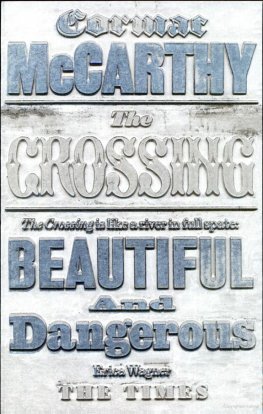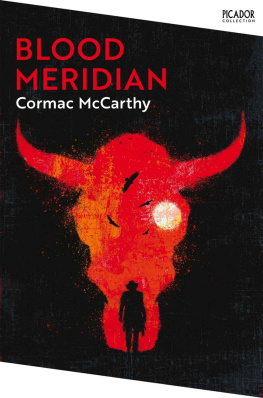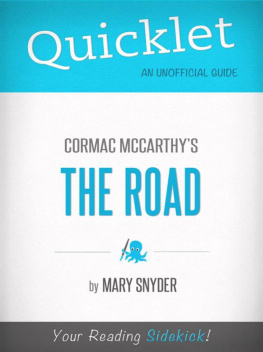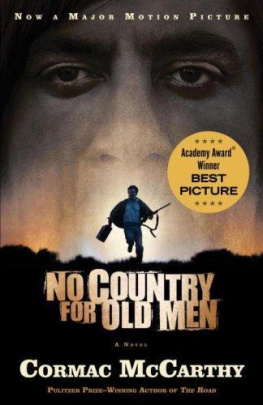
CORMAC McCARTHY S HOUSE
SOUTHWESTERN WRITERS COLLECTION SERIES
The Wittliff Collections at Texas State UniversitySan Marcos
Steven L. Davis, Editor

CORMAC McCARTHYS HOUSE
Reading McCarthy Without Walls
PETER JOSYPH

UNIVERSITY OF TEXAS PRESS,
AUSTIN
The Southwestern Writers Collection Series originates from the Wittliff Collections, a repository of literature, film, music, and southwestern and Mexican photography established at Texas State UniversitySan Marcos.
Copyright 2013 by Peter Josyph
All rights reserved
Printed in the United States of America
First edition, 2013
Portions of this book have been delivered as keynotes for the Cormac McCarthy Society and have been published in the Cormac McCarthy Journal, Appalachian Heritage, and Intertextual and Interdisciplinary Approaches to Cormac McCarthy: Borders and Crossings, edited by Nick Monk.
Exhibitions of Cormac McCarthys House were mounted in the Centennial Museum in El Paso, Texas, in the fall of 1998; in the CAPITAL Centre in Warwick, England, in the summer of 2009; in the Kulturens Hus in Lule, Sweden, in the fall of 2009; and in the Loyal Jones Appalachian Center in Berea, Kentucky, in the spring of 2011.
Requests for permission to reproduce material from this work should be sent to:
Permissions
University of Texas Press
P.O. Box 7819
Austin, TX 787137819
utpress.utexas.edu/about/book-permissions
LIBRARY OF CONGRESS CATALOGING-IN-PUBLICATION DATA
Josyph, Peter.
Cormac McCarthys house : reading McCarthy without walls / by Peter Josyph. First edition.
p cm (Southwestern writers collection series)
Includes bibliographical references and index.
ISBN 978-0-292-74429-5 (cloth : alk. paper)
1. McCarthy, Cormac, 1933 Criticism and interpretation. I. Title.
PS3563.C337Z748 2013
813'.54dc 232012032973
doi:10.7560/744295
ISBN 978-0-292-74528-5 (e-book)
ISBN 978-0-292-74886-6 (individual e-book)
What is not underlined is worthless.
MILLER
... and if Im not writing The Brothers Karamazov
while I read it, Im not doing anything.
GENET
CONTENTS
ILLUSTRATIONS
CORMAC McCARTHY S HOUSE
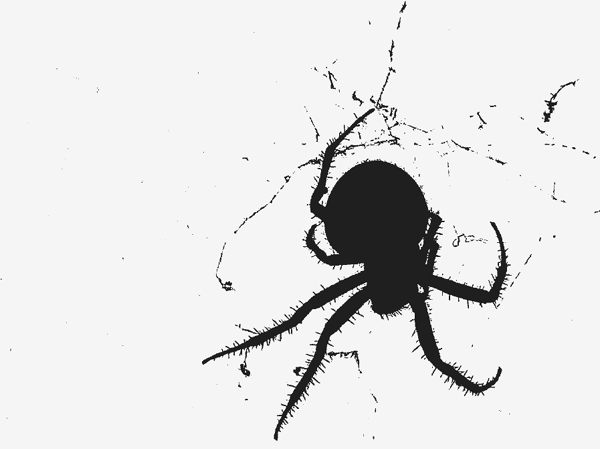
PART ONE
EXCURSIONS AND EXCHANGES
Come, shut your book, were going to have lunch.
PROUST
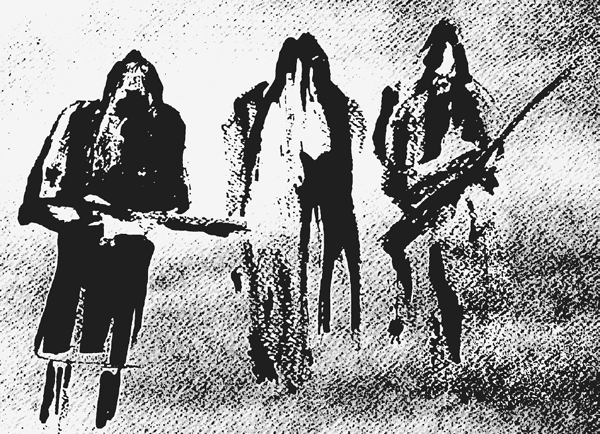
Judging Blood Meridian Or The Evening Redness in the West by Its Cover
1. The Haiku Rebellion
When I was first invited into the anniversary hearings for Blood Meridian Or The Evening Redness in the West at the Southwestern Writers Collection in San Marcos, Texas, McCarthys Portuguese translator, my friend Paulo Faria, had recently embarked on his second offensive against the translational fortress we were going to celebrate, so I thought it might be interesting to follow up Paulos per diem queries to me with counter-queries of my own, as if I too were translating the novelwhich I was, and always am, from pages of anamorphic Panavision to a brain of less spectacular proportions. In the matter of McCarthy, I am never shy of enlisting the aid of better minds.
Paulo did not resist: his responses were based on the closest scrutiny and nearly a decade of pondering.
Translating Blood Meridian is the supreme ceremony, he has told me. I will do it for the rest of my life, always rewriting, always polishing, always from scratch, always the same but always different. I will burst into the temple again and again like Kafkas leopards until my irruption will be part of the ritual of reading Blood Meridian in Portuguese. I will do it until I die.
I had one impediment. I was on strike against producing another work of prose until certain conditions in my professional life were met, and under this injunction I was writing a series of novels in haiku. As I am not a poet, and am disinterested in haiku beyond the Rule of 17, this, to me, was not actual writingit was writing, so to speak, with the left hand. By the time three of these oddments were under way, with hundreds of haiku each, I started to reason, remember, read, even to see in haiku, fingers ever on the move
unclenching to count
my imprisonment in the
number seventeen
Still, the notion of giving a talk on Blood Meridian Or The Evening Redness in the West, fashioned to reflect a Q&A correspondence and yet consisting of haiku exclusively, seemed too perilous a stunt even for a Broadway prestidigitator such as myself. When Harold Bloom said: All that Hamlet, Falstaff and Cleopatra require of you is not to bore them (Genius, 21), he posed a standard for literary intercourse thats easy enough to followif you are Harold Bloom. Can a scrappy New York vaudevillian engage with Judge Holden in a manner that would amuse the Judge himself? Haiku might be absurd enough to turn the trick for him, but would it for you? Probing the novel in haiku is barely a step above probing it in mime and, as with mime, haiku is annoying enough without it Zenning up a monument in Western literature. I envisioned a jetlagged McCarthy enthusiast on pilgrimage from, say, Barcelona, calling his wife and being asked how its going at the conference. Well, MariaI just heard a guy giving a talk in haiku. So then, Maria says, I was rightwe shouldve taken the boys to Disney World. As my self-assigned strike was not general, only against prose, I proposed an exhibition: new works on paper called The Lost Blood Meridian Notebook. For its title alone, how could the home of the McCarthy archive refuse me? I dont know how, but it did. I was stranded in haiku.
The haiku restriction might work better if I confined myself to the dustcover, a notion that had tempted me ever since I first adventured into McCarthy: to meditate the novels through their dustjacketsnot as an opening into McCarthys picture plane or his framing devices... his use of black as a metaphysical color of depth and variety... his landscapes that are always dispatches from the interiorin other words, portraiture... or other paths of legitimate inquiry for readers who have legitimate mindsincluding the issue of whether McCarthys delicious lexiphantism asks you as much to hear his sentences as to picture their anecdotal contentin other words, whether he isnt as much a musician as a painterno, I would see what was there in the jackets themselves. In discussing what is between the covers of a book, cant we carve out at least a little time for the covers? They are the first things we see when we sit down to read, the last that we see when we stop. Clothes make the man, Mark Twain famously said, but we forget, or never hear, the punchline: Naked people have very little influence on society. A stroll through any mass-market bookstore will show you how intensely, almost hysterically, this is now applied to the world of the book. Graphic novelists have been enlisted to illustrate and, really, to author covers and bookflaps for every kind of classic, from Tolstoy to Kerouac, and many of these are more than mere monetary charmersthe best of them have captured the spirit of the book as well as, or better than, decades of fine photography, inventive graphics, and pretty Impressionism from the Muse dOrsay. On the other hand, for my own book
Next page

